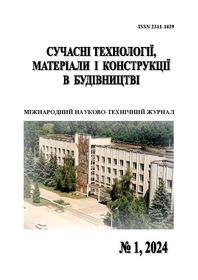FEATURES OF PLANNING REHABILITATION DEPARTMENTS FOR VETERANS: AN ANALYSIS OF INTERNATIONAL EXPERIENCE
DOI:
https://doi.org/10.31649/2311-1429-2024-1-154-160Keywords:
heat transfer, finning, forced convection, specific heat flowAbstract
The heat transfer of a single pipe with transverse round fins during forced convection is considered. A mathematical model is proposed for determining the specific heat flow from a liquid to a gas flow during heat transfer through a cylindrical surface ribbed with round ribs, taking into account the temperature distribution along the height of the plate. The influence of the geometric dimensions of circular fins on heat transfer and specific heat flow through a cylindrical externally finned surface was revealed. According to the results of the simulation of the heat transfer process in the MathCAD environment, it is shown that in case of an increase in the height of the fin, the total heat transfer heat flow increases, but the heat transfer coefficient from the air side decreases in this case, the minimum specific heat flow is observed at a fin diameter of 31...32 mm. The maximum specific heat flow through the finned surface occurs for the fin thickness δ = 2 mm, while the decrease in fin thickness leads to a decrease in the mass of the heat transfer surface and a decrease in the efficiency coefficient of the fin. A significant factor that affects the efficiency of circular transverse pipe fins is the pitch between the fins. An increase in the pitch of the fins on the pipe leads to an increase in the heat transfer coefficient from the side of the fins and a decrease in the specific heat flow. The value of the intensity of heat exchange from the surface of the finned pipe and the specific heat flow through the pipe changes by 1.5...2 times per step between the ribs of 0.005...0.02 m. It was established that the smallest step of finning would be optimal for the heat exchanger, but it is worth considering the technical the economic expediency of modern industrial technologies of finning pipes with aluminum and a significant increase in hydraulic resistance in the event of a decrease in the pitch of the fins on the pipe, which leads to the need to use injection machines of greater prominence and power. The obtained results can be used to optimize the geometric dimensions of tubular gas-water heat exchangers with transverse round fins.
References
Horobets V. G., Bohdan Yu. O., Trokhanyak V. I. Heat exchange equipment for cogeneration plants. Kyiv: CP «Comprint», 2017. 198 p.
Spivak O. Yu., Resident N.V. Heat and mass transfer. Methods of intensification: an electronic training manual for combined (local and network) use [Electronic resource] Vinnytsia: VNTU, 2023. 112 p.
Syasev A. V. Differential equations: study guide. Dnipropetrovsk: Ed. DNU, 2007, 356 p.
Bessel functions. URL: https://en.wikipedia.org/wiki/Bessel_function/ (access date 03/17/2024).
Spivak O. Yu., Resident N.V. Heat and mass transfer. Part I: teaching manual. Vinnytsia: VNTU, 2021. 113 p.
Heat and mass transfer: text of lectures and problems with comments on solutions for students of specialties 7.050601-01 «Heat power» and 7.050601-02 «Energy management»/R.G. Akmen. Kharkiv: NTU «KhPI», 2009. 148 p. URL: https://repository.kpi.kharkov.ua/server/api/core/bitstreams/76518e6b-234c-45a3-bcf3-1060815ead6b/content (access date 03/17/2024).
Downloads
-
pdf (Українська)
Downloads: 54



